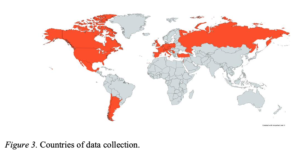Building Bridges Towards Equality
Alexander Levy-Vene and Lily Winston Grob, Beyond Conflict FellowsBuilding Bridges Towards Equality
New study provides insights into how intergroup contact should be structured to promote support for social change
By Alexander Levy-Vene and Lily Winston Grob, Beyond Conflict Fellows
In the face of global social division and conflict, leaders and peacebuilders alike encourage groups to come together in conversation as a first step towards productive unity. President Biden, for example, urged Americans to “come together”, to “see one another”, and to “listen to one another” in his inaugural plea for “unity,” “tolerance” and “humility”. This thinking has been ubiquitous in social movements for a long time; for example, initial efforts towards racial desegregation saw social scientists, policymakers, and civic leaders encourage contact between races to foster improved relations and greater equality.While positive intergroup interactions help achieve unity by reducing negative intergroup attitudes, a wealth of evidence suggests that perceptions of intergroup harmony, evoked by positive cross-group interactions, may undermine disadvantaged groups’ willingness to advocate for greater equality and social justice. This counterintuitive process, termed the “irony of harmony” effect, can lend insight into how social hierarchies are maintained. It also raises an important question: can intergroup contact be structured in such a way that it both improves intergroup attitudes and advances efforts to achieve social change?
Collaborating with a team of 42 researchers from over 20 countries, social psychologist Dr. Tabea Hässler (University of Zurich) suggests that the answer to this question may lie in the psychology of group-specific needs.

In 23 countries with over 11,000 participants, Dr. Hässler and her team studied intergroup contact and support for social change in two intergroup contexts: (1) ethnicity-based inequality and (2) inequality based on sexual orientation and/or gender identity. In both cases, they looked at the difference between advantaged groups (like ethnic majorities and cis-heterosexual people) and disadvantaged groups (like ethnically marginalized and LGBTQ+ peoples).
As the team reports in a newly released article in the Journal of Personality and Social Psychology, whether or not intergroup contact leads members of advantaged and disadvantaged groups to support social change depends on whether members of these groups feel that their needs are met by contact itself. Whereas social harmony can be achieved when members of disadvantaged groups feel that advantaged group members accept them and see them as moral, feeling accepted does not lead members of disadvantaged groups to advocate for social change. Instead, support for social change is increased when members of disadvantaged groups feel “listened to” and “perceived as competent”—what psychologists refer to as empowerment needs. Results suggest that the incompatibility of social harmony and social change is a consequence of contact which fails to address the empowerment needs of disadvantaged groups. As Beyond Conflict researcher, Dr. Michael Pasek (The New School for Social Research), a contributor on the study, explains, “if you don’t feel agency to advocate for yourself, then you won’t.”
“Satisfying the need for empowerment among minorities seems crucial,” agrees another of the study’s collaborators, and Beyond Conflict advisor, Dr. Linda Tropp (University of Massachusetts, Amherst). She suggests that peacebuilding practitioners can consider these findings and employ strategies that “help to move both groups toward recognizing their mutual contributions and value,” such as “openly addressing differences in status and power that may exist between the groups.”
The study’s senior lead, Dr. Johannes Ullrich (University of Zurich), reminds us that study findings do not point to a quick fix: “it’s certainly not easy to implement, because talking about conflict and mentioning continuing injustice makes people feel awkward if they’re on the benefiting side.” Therefore, Dr. Hässler adds, “if disadvantaged group members want to get advantaged group members to really support them and their fight for greater equality, they have to look at the needs of the advantaged.” While this can be hard to do, this research suggests that by making sure advantaged group members feel accepted, and have their basic sense of morality affirmed, their support for social change can actually be strengthened.
Dr. Hässler believes practitioners and the general public should be excited by and embrace the fact that “people can really build bridges in order to achieve equality for all.” So too does this lesson of strength in unity extend to researchers; Dr. Hässler saw the study’s success as highlighting the importance of collaborating with a large, international, and diverse group of researchers, which she believes, “definitely helped us to broaden our perspectives and to bring in perspectives from people that are less heard, like from the global south.”
Going forward, Dr. Hässler plans to explore another puzzle presented by this study: while “accepting” contact consistently increased advantaged groups’ willingness to support disadvantaged groups, it had little effect on their desire to raise awareness of these inequalities amongst their ingroup members. “That’s the big power that elites have—they can talk to their own ingroup to make others aware of existing inequalities. And that’s maybe something that we can reflect on in our everyday life. Do we really try to raise awareness among our peers? Or are we silent?”
This study’s findings have meaningful implications for practitioners in the bridge-building space, Beyond Conflict included, offering important lessons on how to structure contact to best meet the different needs of disadvantaged and advantaged groups to achieve positive social change. As Dr. Pasek explains, “if bridge-building organizations do not heed these lessons, they may inadvertently quell the very social change they seek to promote.”